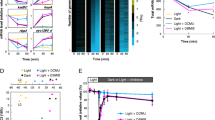Abstract
The cells of the blue-green alga Synechococcus RF-1 stop multiplying and their physiological condition is maintained in a “suspended state” when a continuous-light-grown culture is incubated under continuous darkness. The nitrogenase activity of Synechococcus RF-1 could not be detected while the cells were in the “suspended state”. The circadian nitrogenase activity rhythm could, however, be induced in a 28° C culture by a raised (12 h 28° C/12h 35° C) or a lowered (12 h 28° C/12h 20° C) temperature regimen while the culture was in the “suspended state”. The results indicate that cell division and/or cell growth is not essential for induction of the circadian rhythm in Synechococcus RF-1.
Similar content being viewed by others
Abbreviations
- DD:
-
continuous darkness
- LL:
-
continuous light
- NA:
-
nitrogenase activity
References
Dilworth, M.J. (1966) Acetylene reduction by nitrogen-fixing preparations from Clostridium pasteurianum. Biochim. Biophys. Acta 127, 285–294
Edmunds, L.N., ed (1988) Cellular and molecular basis of biological clocks. Springer-Verlag, New York
Grobbelaar, N., Huang, T.-C., Lin, H.-Y., Chow, T.-J. (1986) Dinitrogen-fixing endogenous rhythm in Synechococcus RF-1. FEMS Microbiol. Letts. 37, 173–177
Huang, T.-C., Chow, T.-J. (1986) New type of N2-fixing unicellular cyanobacterium (blue-green algae). FEMS Microbiol. Letts. 36, 109–110
Huang, T.-C., Chen, H.-M., Pen, S.-Y, Chen, T.-H. (1994) Biological clock in the prokaryote Synechococcus RF-1. Planta 193, 131–136
Kondo, T., Strayer, C.A., Kuldarni, R.D., Taylor, W., Ishiura, M., Golden, S.S., Johnson, C.H. (1993) Circadian rhythms in prokaryotes: luciferase as a reporter of circadian gene expression in cyanobacteria. Proc. Natl. Acad. Sci. USA 90, 5672–5676
Mckane, L., Kandel, J. eds. (1985) Miorobiology: essentials and applications. McGraw-Hill, New York
Mitsui, A., Kumazawa, S., Takahashi, A., Ikemoto, H., Cao, S., Arai, T. (1986) Strategy by which nitrogen-fixing unicellular cyanobacteria grow photoautotrophically. Nature 323, 720–722
Stanier, R.Y., Kunisawa, R., Mandel, M., Cohen-Bazire, G. (1971) Purification and properties of unicellular blue-green algae (order Chroococcales). Bact. Rev. 35, 171–205
Sweeney, B.M., Borgese, M.B. (1989) A circadian rhythm in cell division in a prokaryote, the cyanobacterium Synechococcus WH7803. J. phycol. 25, 183–186
Author information
Authors and Affiliations
Additional information
This work was funded by the Academia Sinica and the National Science Council of the Republic of China. We wish to express our sincere thanks to Dr. N. Grobbelaar, University of Pretoria, for his critical reading of the manuscript.
Rights and permissions
About this article
Cite this article
Huang, TC., Pen, SY. Induction of a circadian rhythm in Synechococcus RF-1 while the cells are in a “suspended state”. Planta 194, 436–438 (1994). https://doi.org/10.1007/BF00197545
Received:
Accepted:
Issue Date:
DOI: https://doi.org/10.1007/BF00197545




